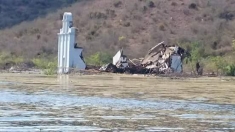The Many Faults of El Quimbo Dam
In June of this year, dam builders began filling the reservoir behind El Quimbo Dam in Colombia. But is it safe?
Construction on El Quimbo Dam, located in the Huila Department on Colombia’s Magdalena River, first started in 2011. The project faced major resistance from residents, who were never consulted by the dam builder Emgesa, a Colombian subsidiary of the Spanish utility Endesa and the Italian utility Enel. Emgesa estimates that the reservoir will be filled completely by early 2016.
Now a new threat has emerged: multiple leaks were recently discovered in the dam. Emgesa officials claim that these fissures are not a serious problem, yet others claim they pose a serious risk, especially considering the dam’s highly seismic location. The Association of Affected Peoples of Quimbo Hydroelectric Project (ASOQUIMBO) consulted outside experts about the leaks, who claim these ruptures are not normal. ASOQUIMBO has been fighting this project since its inception and has kick-started a national movement against harmful dams in Colombia.

In addition to these safety concerns, the reservoir is also inundating the region’s cultural heritage. A 200-year-old chapel, San José de Belén, was recently demolished in order to prepare for the reservoir. The administrative tribunal of Huila authorized the demolition at the request of Emgesa. Close to 600 residents gathered at the church for the last time, grief-stricken by the fact that it would no longer exist. Emgesa plans to build a replicate in a new location, but many fear that Emgesa will not be able to replace or recreate this symbol of cultural and historical identity.
A Checkered Past
El Quimbo Dam is a concrete face, rock-filled dam that stands about 500 feet high and includes an auxiliary dike. The reservoir created by the dam spans approximately 20,000 acres, an area that used to be fertile farmland populated by many small farmers. The fertile lands, before the dam’s construction, were producing high-quality coffee and fruit trees and were also used for cattle ranching and fishing.
Nearly 450 families were evicted from their lands and resettled on less fertile plots of land to allow the filling of the dam’s reservoir. The evicted farmers and their families have found few employment opportunities in their new homes, and they're finding it difficult to renew their previous occupations of fishing and agriculture.
Despite legal requirements, Emgesa never conducted a study on the environmental viability of the project. The dam was also built in a seismic zone, and from the beginning downstream communities have feared that earthquakes could cause dam breakage.
Ignoring these hazards, Colombia’s Comisión de Regulación de Energía y Gas authorized a 20-year contract in 2008, in which Emgesa will receive US $14 per megawatt hour for the power sold to the department. In addition, Emgesa will also be selling electricity to neighboring countries.
El Quimbo Dam continues to be a controversial project. It’s evident that it’s creating much grief for – and posing a risk to – surrounding communities. The Magdalena River continues to be targeted as a profitable and valuable resource for multinational companies to exploit, especially with the multiple proposals for large dam projects now on the table.
According to International River’s Latin America Program Coordinator Monti Aguirre: “It is of utmost importance that Colombia makes smart decisions about what is going to be the future of the Magdalena. Shall the Magdalena be sacrificed and in the name of what or who? While electricity is a modern need, it has also become a great business for consulting and building companies and banks that is imperiling some of the most delicate and important ecosystems on earth.”
El Quimbo, Colombia: Enel-Endesa's 'low carbon' hydroelectric racket
GRAVEDAD DE FALLAS EN EL QUIMBO EXIGEN VERIFICACIÓN Y PLAN DE CONTINGENCIA
San José Belén chapel- Facebook post
News Report of San José Belén chapel-YouTube
“We Need the River to be Free”: Activists Fight the Privatization of Colombia’s Longest River




